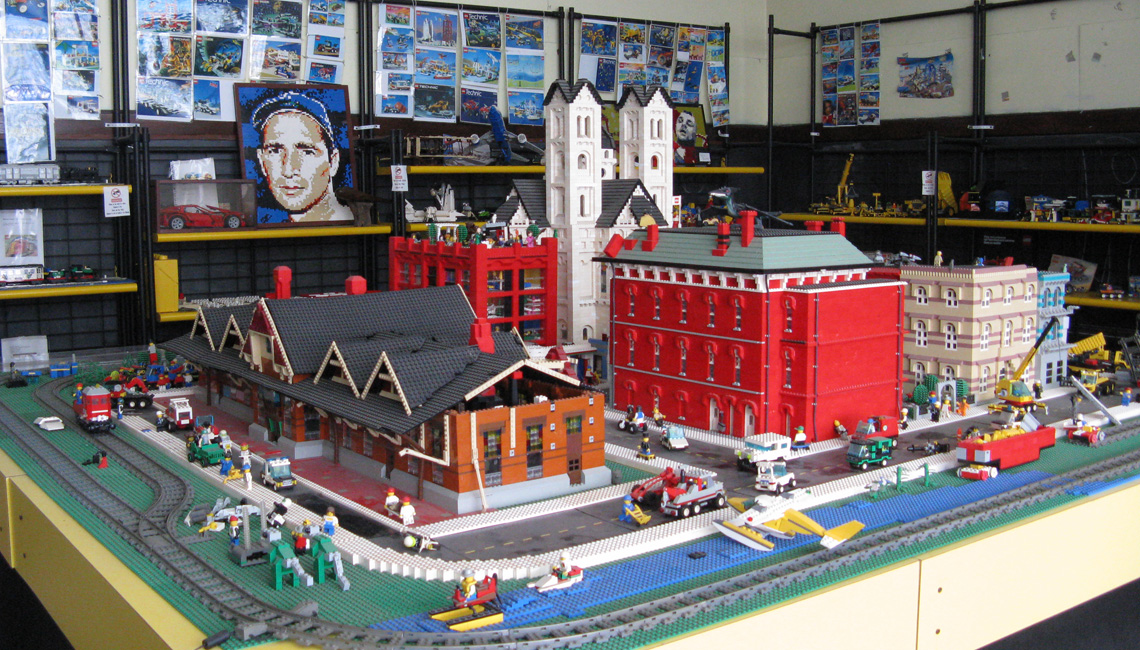Like many kids, Conrad Brown loved Legos. He knew his dad shared that love, too. “I didn’t realize how much we were into Legos,” he says, until his father, Dan Brown, bought Bellaire’s former Gravel Hill school in 2007, with the intent to store his Lego collection in the 1915 building. It wasn’t long before the former school became the Toy and Plastic Brick Museum.
The original plan had been to open an official Lego museum, says Conrad, now 26, but the Danish toy company ultimately backed out, and so the museum is an “unofficial” Lego site. Nevertheless, its displays include many that have been specifically licensed by Lego and given to the museum when they were retired from official Lego sites.
One of the Toy and Brick Museum's prize pieces is a working air conditioning unit.
 The building’s main hallway features life-sized Larry Byrd and Kobe Bryant figures, among others. A prone man made of red Legos appears contemplative inside a case; nearby, a Lego dragon sits at a Lego campfire, roasting a Lego marshmallow.
The building’s main hallway features life-sized Larry Byrd and Kobe Bryant figures, among others. A prone man made of red Legos appears contemplative inside a case; nearby, a Lego dragon sits at a Lego campfire, roasting a Lego marshmallow.
The school building’s classrooms and wide corridors lend themselves to displays, which have been built by Brown and other masters of the plastic brick, including Brian Korte, founder of Brickworkz.com, who in 2007 helped create a gymnasium-floor-sized mosaic with the help of the Bellaire community, including 250 children. “It was a huge team effort to build it,” Dan Brown says.
Almost all the displays are glued — which may be a relief to visitors whose toddlers are given to sudden lunges. Most Lego artists, Dan says, glue each piece as they build their intricate displays.
Some of the ever-changing museum exhibits were donated, while others are tracked down and purchased. A few, including a display of Dora the Explorer, with Diego and the monkey Boots, showed up one day at the museum’s door. The Browns were unable to locate the donors. “We’d love to thank them, but we could never find them,” Conrad says.
Lego artist Eric Harshbarger created the museum’s portrait of Mona Lisa. On Harshbarger’s own internet site, he says he’s the first independent Lego builder to make a living with the plastic bricks. (He also designs puzzles.) Elsewhere in the museum is a Harshbarger chessboard and pieces.
Nathan Sawaya, by some accounts the most famous Lego builder in the world, has a signed — and working — Carrier air conditioner, a speedboat that once held a record for size, a Statue of Liberty with a lightsaber, and in the Western room, a cash register. “Getting a Nathan Sawaya piece is very, very hard,” Conrad says.
Former classrooms house loosely categorized exhibits. In addition to Sawaya’s cash register, the Western room features four card players around a table and Bart Simpson guarding a jailed Milhouse. The Zoo room holds a banana-eating monkey, Garfield the cat, Winnie the Pooh, and a Lego giraffe and baby. The Aqua room has boats: speedboats, sailing ships, Navy and Coast Guard vessels. The Circus room … but you get the idea.
Spider-Man, built by Lego for the 2002 movie of the same name — the Tobey Maguire version — is remarkable in that its plastic blocks look as stretchy as elastic. A portrait of Harry Potter, a Hagrid sculpture, a pachyderm physician attending a bedridden elephant, and a Yoda at the controls of a starship are only a few of the sculptures that fill today’s Gravel Hill school.
One sculpture was created in the museum itself, by an artist visiting from Alaska. “The most creative people make such cool things,” Conrad Brown says. Its actual identity is open to interpretation — could be a dragon, could be a molting chicken or a space creature or maybe a fluffy robot.
In the former principal’s office, near a man in the moon bearing the warning “unglued prototype,” hang the schematics for a trio of leggy musicians — a Lego band that has played gigs all over the museum — currently on a stage in the basement gymnasium, overlooking the giant Lego mosaic created by Dan Brown, Korte, and hundreds of local helpers. When turned on, the band figures light up, play instruments, and sing “Just Imagine” — an old Lego theme song.
A party room is lined with chalkboards, filled with scribbled signatures and comments by celebrants. The gift shop, where visitors also buy tickets, offers a variety of Lego products as well as a bin of loose pieces. Visitors are invited to fill the bag size of their choice.
Still, the focus is on displays that run the gamut from a 13,000-piece Glass City Skyway bridge, a collection of all-white architectural pieces made in China, and a lassoing cowboy on a bucking horse. Lego fanatics will be delighted, and even those who don’t know that “Lego” is derived from “leg godt” — Danish for “play well” — will play very well here.
Toy and Plastic Brick Museum, 4597 Noble St., Bellaire, Ohio, www.brickmuseum.com. Open Tuesday–Sunday, May through August, and select hours during the off-season. Tickets are $8 for adults, $6 for children.

















